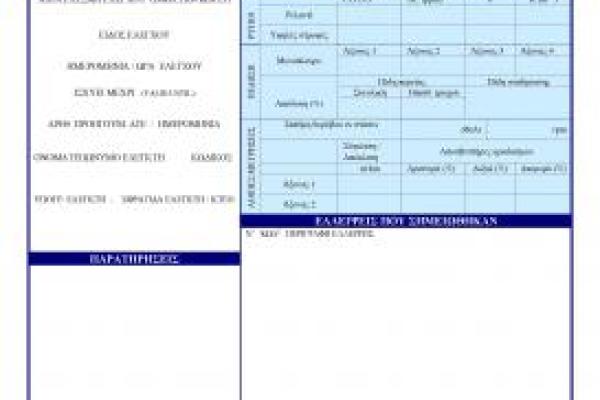General information
General overview
Roadworthiness of a vehicle is attested by a single document, the roadworthiness certificate (DTE in Greek). If no major or dangerous deficiencies are detected, a proof of test, called the mark indicating proof of technical test (ESTE, in Greek) is attached to the vehicle by the public or private testing centre for motor vehicles (the KTEO). Certificates issued after 20/05/2018 bear the EU codes described in Annexe II of directive 2014/45/EU. The vehicle driver must carry the vehicle registration document and the roadworthiness certificate. The roadworthiness certificate is valid up to one week after the expiry date written on it. The authenticity of the roadworthiness certificate authenticity can be checked with the Greek Ministry of Infrastructure and Transport, which holds the KTEO test results. The check is done using the certificate serial number and the KTEO code number, both on the upper right part of the document. The proof of test is attached to the rear registration plate of the vehicle. The proof of test indicates the year of the test and, on the upper part of the document, the month when the next periodic test is due.
Test frequency
|
|
Categories of Vehicles (or description) |
First mandatory test |
Subsequent tests (frequency) |
|
1. |
Μ1, N1, L3e |
Within four years after the date of first registration date |
Every two years |
|
2. |
Μ1 used as taxis or ambulances, M2, M3, N2 and N3 with a maximum mass exceeding 3.5 tonnes, and O3 and O4 trailers with a maximum mass exceeding 3.5 tonnes |
Within one year after the date of first registration |
Every year |
|
3. |
Τ5 tractors used mainly on public roads and with a maximum design speed over 40 km/h |
Within four years after the date of first registration |
Every two years |
Exemptions: Vehicles never or hardly ever used on public roads such as vehicles of historical interest or competition vehicles and vehicles for use by the armed services, civil defence and fire services
Also exempt are: T5 tractors used only on Greek territory on terrain used for agricultural, horticultural, forestry, farming or fishery purposes; vehicles used exclusively on small islands without an operational KTEO or mobile roadworthiness test unit, other than vehicles intended for the carriage of dangerous goods; specialised vehicles with a maximum design speed not exceeding 40 km/h transporting circus and funfair equipment and used only on Greek territory.
Responsible authorities
Documents are issued by the KTEO.
Websites
http://www.yme.gov.gr/?tid=361 (Greek)
Major changes
As of 20/05/2018, provisions of Directive 2014/45/ΕU on roadworthiness tests for motor vehicles are transposed into Greek law through common ministerial order 49372/3352/2017.



